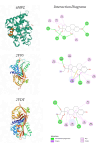An in silico design method of a peptide bioreceptor for cortisol using molecular modelling techniques
- PMID: 39333310
- PMCID: PMC11436820
- DOI: 10.1038/s41598-024-73044-0
An in silico design method of a peptide bioreceptor for cortisol using molecular modelling techniques
Abstract
Cortisol is established as a reliable biomarker for stress prompting intensified research in developing wearable sensors to detect it via eccrine sweat. Since cortisol is present in sweat in trace quantities, typically 8-140 ng/mL, developing such biosensors necessitates the design of bioreceptors with appropriate sensitivity and selectivity. In this work, we present a systematic biomimetic methodology and a semi-automated high-throughput screening tool which enables rapid selection of bioreceptors as compared to ab initio design of peptides via computational peptidology. Candidate proteins from databases are selected via molecular docking and ranked according to their binding affinities by conducting automated AutoDock Vina scoring simulations. These candidate proteins are then validated via full atomistic steered molecular dynamics computations including umbrella sampling to estimate the potential of mean force using GROMACS version 2022.6. These explicit molecular dynamic calculations are carried out in an eccrine sweat environment taking into consideration the protein dynamics and solvent effects. Subsequently, we present a candidate baseline peptide bioreceptor selected as a contiguous sequence of amino acids from the selected protein binding pocket favourably interacting with the target ligand (i.e., cortisol) from the active binding site of the proteins and maintaining its tertiary structure. A unique cysteine residue introduced at the N-terminus allows orientation-specific surface immobilization of the peptide onto the gold electrodes and to ensure exposure of the binding site. Comparative binding affinity simulations of this peptide with the target ligand along with commonly interfering species e.g., progesterone, testosterone and glucose are also presented to demonstrate the validity of this proposed peptide as a candidate baseline bioreceptor for future cortisol biosensor development.
Keywords: Computational peptidology; Cortisol bioreceptor; De novo peptide design; High-throughput screening; Molecular docking; Molecular dynamics; Umbrella sampling.
© 2024. The Author(s).
Conflict of interest statement
The authors declare no competing interests.
Figures








Similar articles
-
Molecular Dynamics Model for Developing Wearable Biosensors.Annu Int Conf IEEE Eng Med Biol Soc. 2024 Jul;2024:1-4. doi: 10.1109/EMBC53108.2024.10782196. Annu Int Conf IEEE Eng Med Biol Soc. 2024. PMID: 40039213
-
Development of an insilico model of eccrine sweat using molecular modelling techniques.Sci Rep. 2022 Nov 24;12(1):20263. doi: 10.1038/s41598-022-24440-x. Sci Rep. 2022. PMID: 36424428 Free PMC article.
-
Bioinformatics design of peptide binding to the human cardiac troponin I (cTnI) in biosensor development for myocardial infarction diagnosis.PLoS One. 2024 Oct 22;19(10):e0305770. doi: 10.1371/journal.pone.0305770. eCollection 2024. PLoS One. 2024. PMID: 39436888 Free PMC article.
-
Evaluation of sweat-based biomarkers using wearable biosensors for monitoring stress and fatigue: a systematic review.Int J Occup Saf Ergon. 2024 Sep;30(3):677-703. doi: 10.1080/10803548.2024.2330242. Epub 2024 Apr 6. Int J Occup Saf Ergon. 2024. PMID: 38581242
-
Molecular dynamics in drug design.Eur J Med Chem. 2015 Feb 16;91:4-14. doi: 10.1016/j.ejmech.2014.08.004. Epub 2014 Aug 4. Eur J Med Chem. 2015. PMID: 25108504 Review.
References
-
- Bandodkar, A. J., Ghaffari, R. & Rogers, J. A. Don’t sweat it: The Quest for wearable stress sensors. Matter. 2, 795–797 (2020).
-
- Cheng, C. et al. Battery-free, wireless, and flexible electrochemical patch for in situ analysis of sweat cortisol via near field communication. Biosens. Bioelectron.10.1016/j.bios.2020.112782 (2021). - PubMed
-
- Russell, E., Koren, G., Rieder, M. & Van Uum, S. H. M. The detection of cortisol in human sweat. Ther. Drug Monit.10.1097/ftd.0b013e31829daa0a (2013). - PubMed
MeSH terms
Substances
LinkOut - more resources
Full Text Sources

